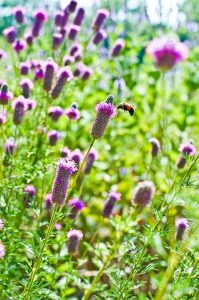We may be headed into fall colors, cooler weather, and less daylight, but gardening doesn’t have to be all about preparing our garden beds for winter. There is still time to add native plants to your landscape to provide food and habitat for pollinators like bees and butterflies next spring and summer. Fall is actually a wonderful time to plant native plants to give them a head start on the next growing season.
Why do we recommend planting native plants for pollinators? Native plants are well suited to Minnesota’s environment and growing season, which means they typically don’t need much water or fertilizer to do well. Talk about low maintenance! They also typically have long roots that prevent erosion by anchoring the soil and filter pollutants from stormwater runoff. This means that native plants do a great job at keeping our lakes, streams and wetlands clean.
The fact that many native plants also attract pollinators is a win-win, as butterflies, bees and other pollinators are important for food production and healthy ecosystems. As they hop from plant to plant, pollinators help ensure the reproduction of plants that supply the foods we (and other animals) eat, the flowers we enjoy, and the medicine we need to treat illnesses. Unfortunately, we are seeing fewer bees, butterflies and other pollinators because of habitat loss, invasive species, diseases and parasites, chemical use, and climate change. While these are big problems, we can all do our part by planting native plants that improve water quality and support pollinators. As more people take action, the bigger the benefit!
When selecting plants, be sure to pick plants that will do well in your soil and sun conditions. And, if you have the space, choose a variety of plants that bloom at different times of the year to provide a continuous supply of food for pollinators (and gorgeous color in your landscape) throughout the spring, summer, and fall. Check out Blue Thumb’s plant finder for ideas: http://www.blue-thumb.org/plants/.
You can generally plant native pollinator plants until about mid-October (our average ground freeze is mid-November), which provides the plants a head start on the next growing season. After planting, continue to water the plants until the ground freezes to help the roots get established. Once spring comes around, the roots will continue to grow as soon as the ground thaws, giving the plants a head start on any spring transplants.
The cooler weather doesn’t have to stop you from getting out and adding beauty and function to your yard. We hope you have fun adding some new plants to your garden that will support pollinators while also improving water quality. Learn more at www.minnehahacreek.org/education.
An online version of this article can be found at https://www.minnehahacreek.org/blog/provide-pollinators-fall. Thanks to the Minnehaha Creek Watershed District for the contents of this article.



